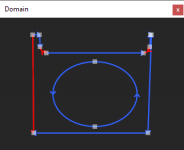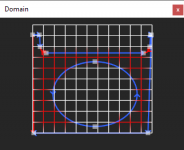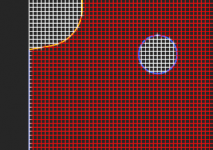Here's another issue I came across, and I do not have any solution so far. What I'm doing is sampling CAD faces in their UV spaces with uniform grids. Something like that:

And with the grid overlay:

The red color means that the corresponding point falls inside the parametric domain of a face. The white color means that the corresponding point is outside. For that test, I use the good old
Has anyone ever implemented fast PMC for 2D contours?

And with the grid overlay:

The red color means that the corresponding point falls inside the parametric domain of a face. The white color means that the corresponding point is outside. For that test, I use the good old
IntTools_FClass2d and it appears to be not that good (just old). The problem is the performance and now I'm looking for a better way of point-face classification.Has anyone ever implemented fast PMC for 2D contours?




